The Christmas Tree and its Origins
The Christmas Tree
Lately, a spruce or fir, decked with baubles, bangles, and lights, has been the centerpiece of the celebration.
The custom is German, reportedly beginning in the eighth century when St. Boniface dedicated a fir tree to the Holy Child.
It was done as a counter to the sacred oak of Odin and in the spirit of Tertullian of Carthage, who had made a statement during a third-century treatise on idolatry,
An early German Christmas tree bears fruit on its boughs. Originally, the apples and oranges had been sacramental wafers.
They gave way to today's brightly colored balls.
"You are a light of the world, a tree ever green, if you have renounced the heathen temple, make not such a temple your home."
However, the most popular legend insists that the first was cut down by Martin Luther, who brought it home and decorated it with candles to imitate "the starry skies of Bethlehem that Holy Night."
Under it, Luther put a crèche and figures of Joseph, Mary, the child Jesus, and various animals.
The first "tree of record" is the one raised in Strassburg in 1604.
In 1837, Princess Helen of Mecklenburg brought the custom to France after her marriage to the Duke of Orléans.
In 1844, it spread to England when Prince Albert of Saxony and Queen Victoria "had a tree" at Windsor Castle for the pleasure of the royal children.
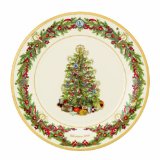
Although such trees were introduced to America with the various waves of German settlement and by the Hessians during the American Revolution, the first national recognition of the custom came in 1856 when Nathaniel Hawthorne's old friend Franklin Pierce decorated one at the White House.
By the First World War, community trees at Madison Square Park in New York, on the commons in Boston, on Mt. Wilson in. Pasadena were erected, and in the 1920's Altadena developed its famous milelong vista of lighted giant deodar cedars.
The ninety-foot Norway spruce at Rockefeller Center in 1948 was the tallest tree many people had ever seen, but it was dwarfed by Seattle's 212-footer of 1950.
Holiday Christmas Tree
Buy Christmas trees for your home and family,
artificial Christmas trees, aluminum, pre lite, real Christmas
trees, plus Christmas lights and decorations.
Christmas Tree Ornaments
Nevertheless, few have symbolized the "ever green" spirit of Tertullian better than the first one known to Clear Creek, Kentucky, cut by Mom Ritchie, folksinger Jean's hill-country mother:
...I'd read about 'em having Christmas trees, and I went down the creek way a piece. I'us looking for an evergreen, and I couldn't find one, so I cut a sourwood tree -- had all the tags a-hanging on it, and I decorated it with red ribbon, red paper, popcorn, and red apples. It pleased the children so well that they've had one ever since.
Most people have heard that the custom originates in the tannenbaum and is some sort of vestige of Teutonic vegetation worship. This is partially true.
However, the custom of using pine and other evergreens ceremonially was well established at the Roman Saturnalia, even earlier in Egypt.
St. Boniface didn't choose his fir-tree without precedent. Furthermore, there had been in the medieval mysteries the dramatic custom of depicting the entire Garden of Eden by one, apple-decorated fir, and this did much to tie the evergreen to Christ's birth.
The Paradise play is particularly important. It followed the Expulsion with a hopeful reference to the coming of the Saviour,
This idea of decorating homes on holidays is both worldwide and age-old.
In Scandinavia the reference to it is thought to begin around the 18th century. In the cities it became known around 1830 and by 1840 it had become common enough in Norway to be mentioned in Henrik Wergeland's poem "Wintersong": "Joy is not chilled - happy eyes see the glow of the christmas tree, christmas is approaching"
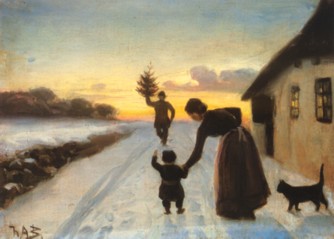
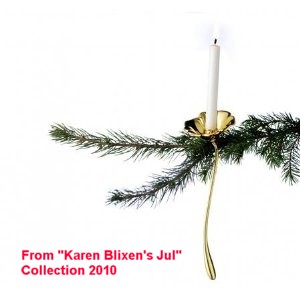
Danish painter H.A. Brendekilde's "Arrival of the Christmas Tree"
The custom is believed to have come from south-west Germany to Scandinavia. In Germany and Switzerland it was already from about the year 1500 the custom to decorate christmas trees for social occasions at auditoriums and business associations.
After the reformation the protestants adopted the custom of christmas trees when they organized their christmas "fests".
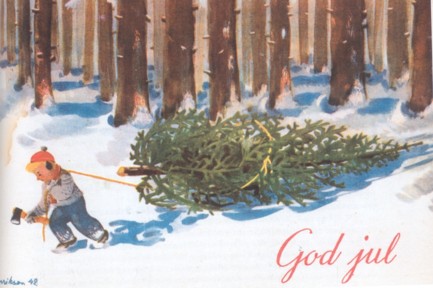
Cutting and bringing home the Christmas Tree, from a Norwegian Christmas Card
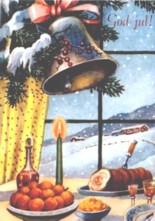
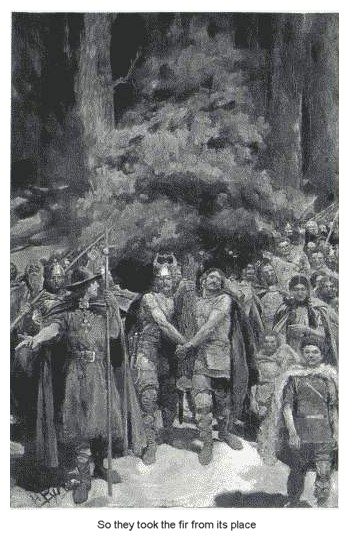
The word "juletrefest" in Norwegian is difficult to translate into English, but these festivities are an integral part of the celebration of the christmas season to this day.
They are occasions to get together to sing christmas carols around the tree, perhaps hear a public speaker and enjoy food and coffee being served.
The above illustration represents a wintry scene in Norway at Christmas time
These "fests" can go on well into January.
It is only natural that in addition to fire and trees, flowers and other plants would be used to "deck the halls" at a ceremony as significant as Christmas.
So the Saturnalian laurel, the Teutonic holly, the Celtic mistletoe, and the Mexican poinsettia have all attached themselves to this polyglot ceremony, along with rosemary, ivy, spruce, cherry, lilies, and most anything the land will give forth.
And to the right - the legend of the first fir tree
"And here," said he, as his eyes fell on a young fir-tree, standing straight and green, with its top pointing towards the stars, amid the divided ruins of the fallen oak, "here is the living tree, with no stain of blood upon it, that shall be the sign of your new worship.
See how it points to the sky. Let us call it the tree of the Christ-child. Take it up and carry it to the chieftain's hall. You shall go no more into the shadows of the forest to keep your feasts with secret rites of shame. You shall keep them at home, with laughter and song and rites of love.
The thunder-oak has fallen, and I think the day is coming when there shall not be a home where the children are not gathered around the green fir-tree to rejoice in the birth-night of Christ."
So they took the little fir from its place, and carried it in joyous procession to the edge of the glade, and laid it on the sledge.
The horses tossed their heads and drew their load bravely, as if the new burden had made it lighter.

Particularly popular in America today is the "flower of the Holy Night," representing the flaming Star of Bethlehem through its red bracts and named after the United States ambassador to Mexico,
Joel R. Poinsett.
In 1829, he brought the plant back to his home in South Carolina, and its popularity at Christmas has waxed ever since. Mexican legend has the poinsettia originate in a miracle.
A poor boy, with nothing to offer Christ at the local church, falls on his knees reassuring God how much he would like to give the gift he has no money to buy. As he rises, there springs from the ground at his feet the first "flower of the Holy Night." He breaks some of the branches with their flaming bracts and lays his gift at the altar.
The Fir Tree - by HC Andersen